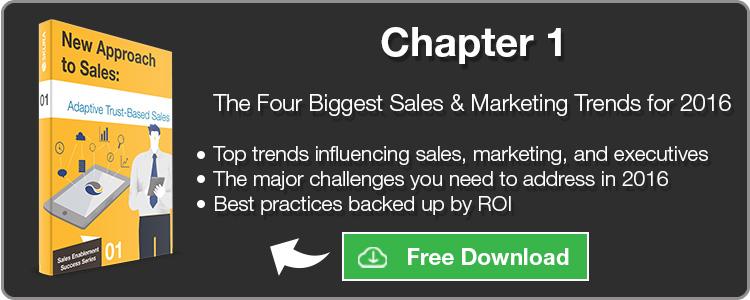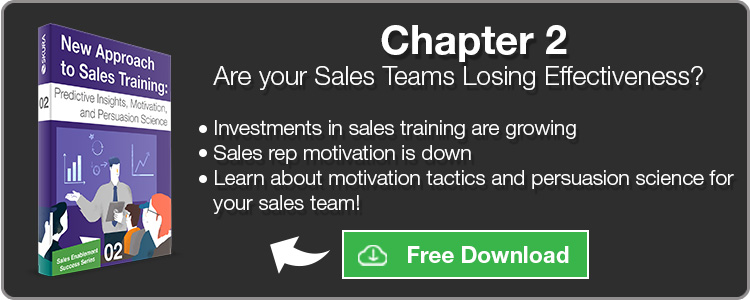In our third installment, we delve into the tricky business of responding to objections. We detail a 3-step strategy to employ, things to always keep in mind, and ways that predictive data analytics can reshape the entire challenge.
Buyers will always raise objections throughout the sales process. Empowered buyers are a challenge we help businesses with every day at SKURA and it’s also something we deal with at the same time. They not only raise objections more often, their objections are more complex and thus more difficult to answer and require additional time that many sales reps no longer have.
For a refresh of the types of objections, I suggest reading our previous article in this series entitled responding to common objections in the sales process.
 (Image Source: Silver-Money, 2015)
(Image Source: Silver-Money, 2015)
Handling Objections
When an objection arises, you are faced with an immediate decision to respond then and there, or postpone the response.
If you’ve been following the ‘Sales Objection Series’, you’ll know that postponing, though common, is a dangerous play that may leave you open to competitive action.
You must use your insight to gauge whether the objection is valid or not, as the buyer could just be using a negotiating tactic. You are responsible for appropriate conduct during the response phase.
Step One
BE POSITIVE. I cannot stress this enough. An objection should be seen as interest in the solution. Your response should be insightful, positive, and rewarding to the buyer.
Step Two
Apply the LAARC method. (Source: Raishidmuneer, 2016)
LAARC is a handy acronym for handling objections. Applying these steps can help you structure your responses to objections, allowing you to just focus on solving the problem at hand.
Listen – The first step is to listen and understand the objection. If you jump to respond, you could miss a valuable opportunity to build trust in the relationship.
Acknowledge – Regardless of whether you think this objection is valid or not, you must acknowledge the objection. Show that you appreciate the objection with a sincere concern for their view. Remember, even if you don’t find it valid, you should be concerned that they do.
Assess – Show that you are actively interested in this objection. Ask questions to further clarify the objection. The trick to knowing that you’ve completed this phase is having empathy for their objection.
Respond – This is where you apply an objection-handling technique. Stay on course, respond to the objection and avoid veering to other topics as this may insult the buyer and show a lack of appreciation.
Confirm – This is the last step in responding the objections. Ask the buyer if they are satisfied with the response. Confirm that there is no longer any hidden doubt. This will enable you to progress through to the next stage of the sales process.
Using LAARC without saying a word
You can enhance LAARC with integrated mobile sales applications that monitor digital content consumption.
Prior to any sales presentation, you can monitor the consumption of digital content from the buyer, allowing you to understand (listen to) their needs.
Patterns of engagement across specific content types show areas of concern in the buyer, allowing you to acknowledge buyer motives and concerns.
Assess the concerns by putting together a sales playbook of relevant material ahead of the sales presentation or next discussion with the buyer. This way you can empathize with their concerns long before hearing about them.
Now you can respond and this is where you get to WOW the buyer. You may respond by sharing the relevant material through your mobile sales enablement software, and simply state that you are providing more content for their pleasure. Alternatively, you can hold the content as ammunition for the next meeting.
Finally, you confirm that you’ve addressed the objection. If you pre-emptively addressed the objection by sharing digital content, you can monitor the consumption. If you see that the buyer consumed the new content several times and shared it with others, it’s a safe bet that you hit a bullseye. If this was done in person, you can just ask.
If you aren’t familiar with the new trends influencing sales in every industry, may I suggest downloading the FREE whitepaper below which illustrates the new approach to sales, and trends influencing sales and marketing.
Step Three
Traditional Techniques for Responding to Objections
During the ‘respond’ phase of LAARC, you can apply any of the following strategies, provided that they are appropriate to the circumstances. In some of these cases, digital content management software like sales enablement can be used to optimize the encounter and improve efficiency.
Tipping the bucket
This is a strategy whereby you ask the buyer to lay out all of their objections on paper and you slowly cross them out as you address each objection.
Strengths – This can work well as it shows the buyer that you’re there to help them achieve their objectives, and that you’re prepared to address their concerns front and center.
Weaknesses – This kind of strategy could seem wasteful to the buyer, and you may appear to be unfamiliar with the client and their specific needs.
Technology Enablement – You can leverage a mobile digital content management platform to cut the time between responding to each objection.
A Forestall or Pre-empting Objection
This is a strategy of discussing objections prior to them being brought up. You refer to past buyers feeling a certain way, and resolve the concern in the process.
Strengths – This kind of strategy shows that your concerns are with the buyer and their needs.
Weaknesses – You may risk highlighting objections that the buyer did not have, and may not have otherwise had.
Technology Enablement – You can use predictive analytics to see the patterns of consumption exhibited by the buyer and pre-empt only those objections you foresee as being likely. This reduces the weakness of this strategy.
Denial or Push-Back
If you find that the objection isn’t valid, you can assertively (not rudely or aggressively) respond to the objection by telling them they are wrong.
Strengths – If done well, you can position yourself as a trusted ally who wants the best for your buyer. You effectively 'shock' the buyer. This works best when the objection is a deception tactic.
Weaknesses – If done incorrectly, it may insult the buyer.
Technology Enablement – You can immediately back-up your position with digital content-based evidence that you otherwise wouldn’t have had at the time.
Reframe the Objection
The buyer may have a misunderstanding on the objection. You can avoid saying “no” by turning the objection into a reason to buy, or helping them understand the objection with new data.
Strengths – A reframing of the objection could allow them to see it in a new light. It could also make it more difficult to use the objection again without being argumentative.
Weaknesses – This requires a higher degree of skill and practice. If done incorrectly, it could put you in a weaker position for the sale.
Technology Enablement – As objections become common in your sales process, you will develop sales playbooks to counter each interaction. Your playbook can come in handy for these kinds of interactions, as they are based on proven outcomes in the past.
Compensate or Reprioritize
You change the priority of the objection by countering with an opposing benefit that outweighs the objection. Ideally you can appeal to their priorities when compensating an objection. This works best on minor objections and price objections.
Strengths – Can be an easy way to change the focus away from an objection.
Weaknesses – If you miss on buyer priorities, you risk damaging the trust in the relationship.
Technology Enablement – A heavy roster of digital sales aids allow you to back up claims with evidence in the moment that it’s needed.
Questioning and ‘Coming-to-That’
Sometimes an objection can leave you off balance. It can be a good idea to ask more questions if you aren’t satisfied with your potential response at that moment. You can also tell the buyer that you were ‘coming to that’. Depending on your comfort, you can use the added time to craft a response in line with what you’re saying.
Strengths – This allows you to buy time while crafting a response to suit the buyer.
Weaknesses – If done poorly, the buyer could see your strategy as stalling and this could get worse if they ask you to answer it in that moment.
Technology Enablement – Objections that outweigh your on-hand knowledge can be prepared for in advance before a meeting by reviewing the buyer’s consumption of content. The outcome of each call is recorded to CRM automatically, and this allows the next encounter like this to be smoother.
Pass-up
The last option you have is to simply pass-up the objection. This isn’t an ideal situation, but it does have a time and a place. Sometimes a buyer can make an objection that has no effective way of disputing, such as “venting” frustration or personal opinion. The best course of action is to acknowledge the objection, pause briefly, and move on. Ask for the sale and move on.
Strengths – It can allow you to avoid dwelling on an issue that has no effective response.
Weaknesses – Though it may have happened anyway, this could be the end of the sale.
Technology Enablement – In this case, the strength of a sales enablement system is in the closed loop marketing integration. There may be a pattern to understand which led the buyer to this place. For example, multiple marketing communications due to account duplication could have frustrated the buyer. If the sale was lost, this offers an opportunity to avoid similar situations in the future.
Responding to Objections from the 21st Century Buyer
The challenge of objections isn’t new, but the empowered buyer is turning the tables on many sellers, especially in lagging industries. There is no doubt that a buyer self-educates, leveraging social media and other online sources to create complex buying criteria.
Many offer more sales training as a remedy, but our research has shown that more training risks damaging the confidence of the seller. In order to address these challenges, sales reps need insight to inspire motivation and confidence.
To learn more about the limitations of sales training, the new adaptive approach to sales, and the science of persuasion, click the link below for a FREE download.












